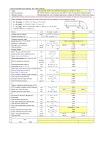Are you searching for a practical handbook that will assist you in the process of designing heating, ventilating, and air-conditioning (HVAC) systems for commercial buildings? The HVAC Design Sourcebook is the tool you need to quickly become a valuable member of your design team.
The typical approach to training junior employees in the process of designing HVAC systems is to have them try to learn the skills they need to work as effective members of a design team from the senior HV AC engineers they are working under. Unfortunately, the knowledge the senior engineers are expected to impart has taken them years to develop and, without a practical training resource, the process of teaching junior HVAC system designers the essentials of HVAC system design becomes time consuming, ineffective, and costly.
The HVAC Design Sourcebook fills the void in the industry for a practical resource to assist in the process of training junior HVAC system designers in the basics of HVAC system design. Essential design concepts are dearly explained and illustrated with photographs of actual HVAC systems installations and graphical conventions used in the preparation of construction drawings. Codes and standards are referenced frequently to emphasize the need for HVAC systems to be designed in accordance with the requirements of the regulating authorities. Other topics such as the overall design process, HVAC systems and equipment, piping and ductwork distribution systems, noise and vibration control, and automatic temperature controls are presented in a manner that can be understood and applied by the junior HVAC system designer. The ultimate goal of preparing complete, well-coordinated HVAC system construction drawings is consistently in view throughout the book.
Table of Content :-
- The design process
- Piping, valves, and specialties
- Central plant and air systems
- Piping and ductwork distribution systems
- Terminal equipment
- Variable refrigerant flow systems
- Humidity control
- Noise and vibration control
- Automatic temperature controls
- Sustainability
- Construction drawings
- Central plant optimization
- Construction administration
- The commissioning process










-page-001.jpg)


0 Comments